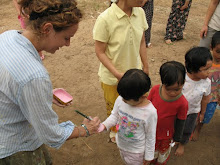For our final week, Artful Integration explored the intrinsic value of the arts. We started with a drawing project inspired by U.S. painter Georgia O'Keeffe's quote:
"Nobody sees a flower, really, it is so small it takes time - we haven't time - and to see takes time, like to have a friend takes time."
Educators first prepared their hands and eyes for the drawing session by filling in a floral warm-up using thin black pens.
Next, they choose a real flower to draw and spent some time "seeing" the flower, as careful observation is an integral aspect of the drawing process. Educators used magnifying glasses to aid them in noticing all the intricate details that compose one flower.
Participants then drew the contours--or outlines--of the flowers using bright colored pencil on black paper. This provided an opportunity to practice transfer what they'd seen onto paper without using an eraser.
After finishing their initial study on black paper, the artists drew the flower again using both thin and thick pens to create variety in their compositions. Some chose to use crayons to add a touch of color.
Others opted for watercolor in addition to their crayons to add the rich colors they found in their flowers.
Some enjoyed the striking contrast of black on white and chose not to add color at all.

Another high contrast choice was made by this artist, who chose to mount her cut out drawing on bright orange paper.
The result was a series of gorgeous drawings, as varied as the individuals that made them.
In a discussion afterwards, we talked about the importance of creating a "safe" space for art-making, where participants feel supported and not afraid of making mistakes. Rather, mistakes are opportunities!
We also talked about the value of spending time cultivating focus and careful observation.
Continuing the exploration of the intrinsic value of the arts, Zach, another teacher at Ascend, led the group in two theater exercises. In the first, "One Word Story," we went around in a circle told a tale of a kitten and a swimming tiger using just one word each. This created a collaborative creative space to follow others' leads in order to invent a story.
The next exercise sounds deceivingly simple. The group must count to 20, with only one person saying each number in no assigned order and without making eye contact. If more than one person says the same number at the same time, the entire group must start over at 1. It took us a while to attain the necessary group focus, but everyone cheered enthusiastically when we finally got to 20! It was a great way to illustrate collective buy-in to a very focused activity. Other educators suggested using this activity to help center a group of excited kids before beginning a project.
Finally, we shared resources and made plans for next actions we could take. Some educators are going to start blogs of their own, or prepare online photo albums of project ideas sorted by material. Others are planning lessons or discussions to share what they've learned at their respective schools. We are all excited to see what amazing creations will be the aftermath of these sessions!
Websites:
Monart Method Mona Brook's method of teaching drawing through an "alphabet" of shapes.
Art is Messy Photo-filled blog from an art teacher in China--the blogroll has many more opportunities.
Briargrove Elementary Another teacher's blog packed with elementary school age projects.
How to Draw It A series of free and comprehensive drawing lessons online.
Fit For A Feast Kids teach kids how to dance in these online lessons.
Studio Thinking by Lois Hetland, Ellen Winner, Shirley Veneema, Kimberly M. Sheridan
Emphasis Art: A Qualitative Art Program for Elementary and Middle Schools by Frank Wachowiak
Out of the Box: Creating Art and Craft with Waste Published by the Centre for Environmental Research & Education
Art Fundamentals: Theory and Practice Published by McGraw Hill
Getting to Know the World's Greatest Artists by Mike Venezia
Teaching art and design 3-11 Edited by Sue Cox and Robert Watts
Ideas:
Have kids study great artists and learn about their styles
One-Word Story theater game
Count to 20 theater game
Studying in-depth the art traditions of one country
Studying art traditions of the world












































